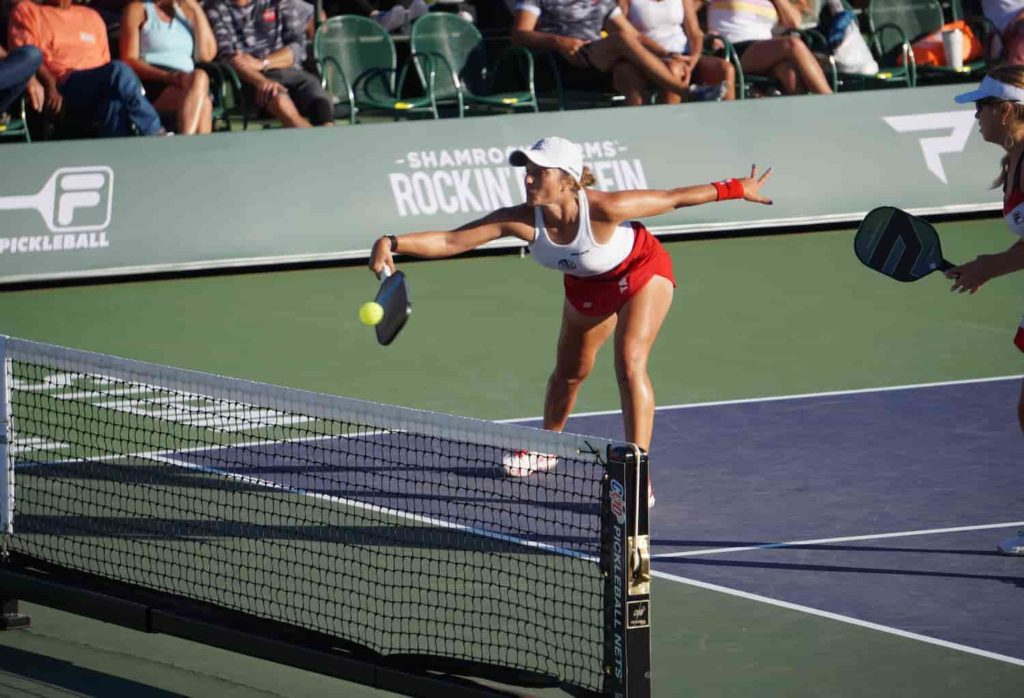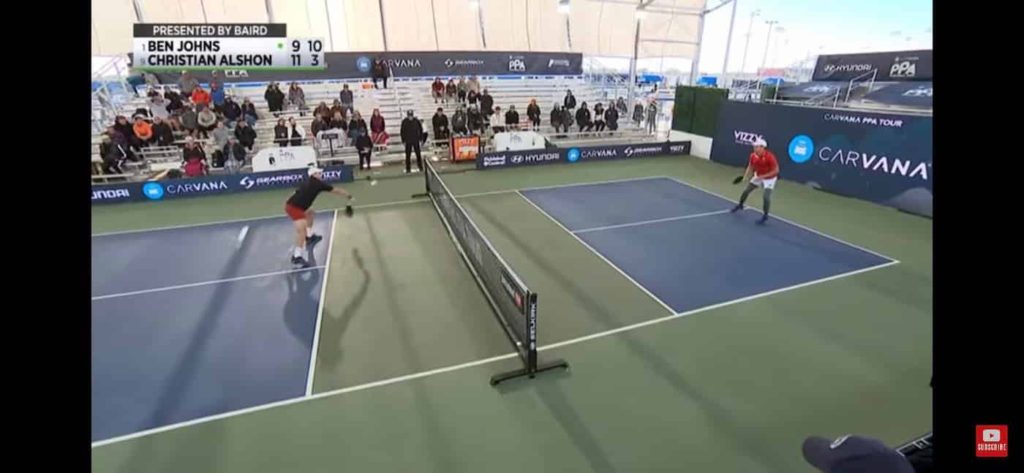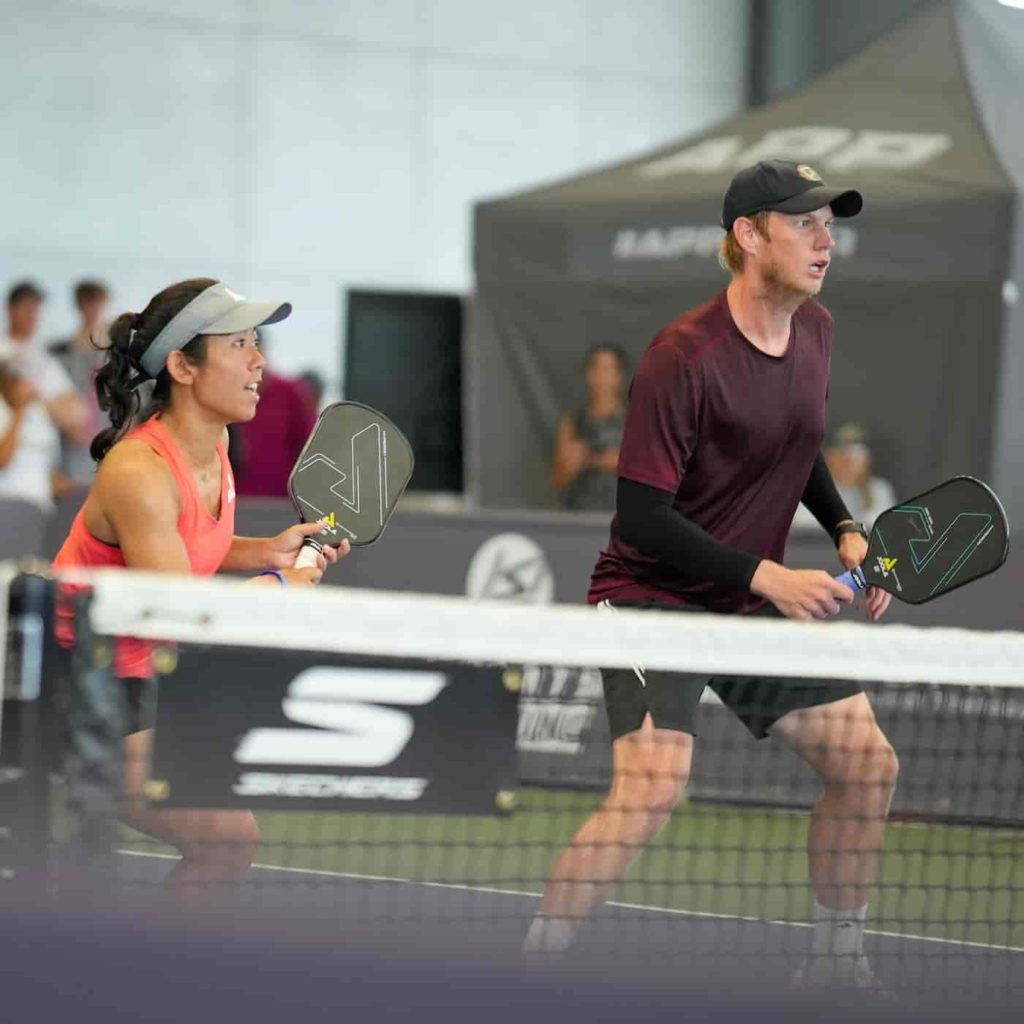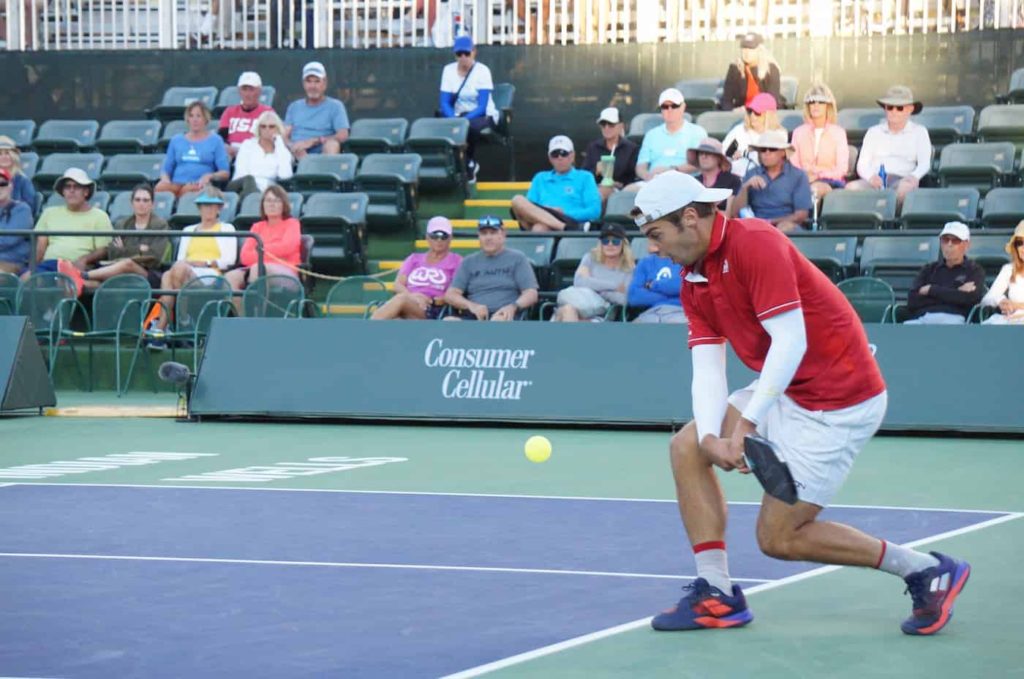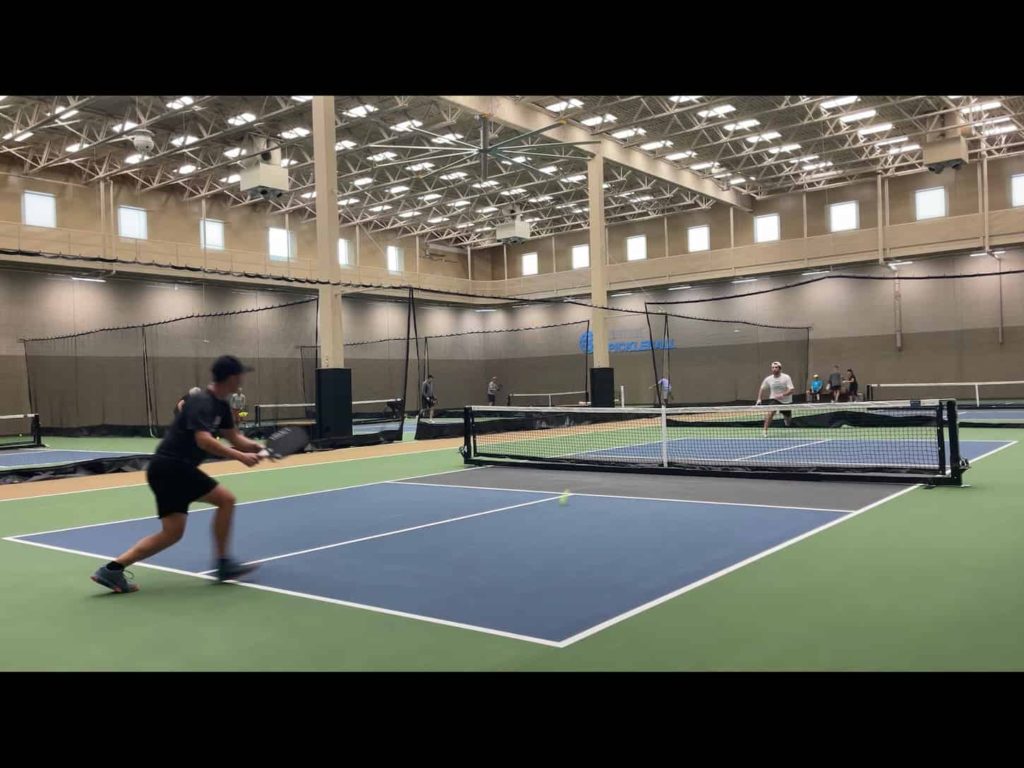Introduction
Pickleball is a game that requires both physical and mental agility. The sport is played on a court surface with a net, similar to tennis but with smaller equipment.
Footwork in pickleball refers to the movements players make on the court using their feet. Proper footwork technique can help players improve their speed, agility, and balance while reducing the risk of injury.
What is Pickleball Footwork?
Pickleball footwork refers to the movement techniques used by players to position themselves on the court to return or hit a ball effectively. The game requires quick footwork as players must constantly move back and forth across the court, side-to-side, and forward or backward while also staying in position to make precise shots. Players use different footwork techniques depending on their position on the court and where they expect their opponents will hit the ball. Basic techniques include:
The ready position where a player stands balanced with feet shoulder-width apart and knees slightly bent
Split step technique used for faster reactions
Step and slide technique for moving forward quickly while maintaining balance
Cross-over step technique for lateral movements
Reverse step technique for backpedaling moves
Hop back technique, which allows you to recover quickly when you are caught off guard.
Importance of Footwork in Pickleball
Footwork plays an essential role in pickleball since it facilitates proper positioning, effective shot-making, and efficient movement around the court. Players who have mastered basic footwork techniques can move easily around the court without getting stuck in one place during play. Without proper footwork your pickleball game will not reach the next level.
By mastering footwork skills, players can improve their game strategy by anticipating where they need to be positioned before hitting or returning shots. Properly executed footwork increases speed, agility, mobility, coordination as well as prevents injuries such as ankle sprains or knee strains that may occur due to sudden movements.
Overview of the Article
This article will explore different footwork techniques used in pickleball, including basic and advanced patterns. We will discuss the importance of proper footwork and how it can lead to better play. Our aim is to provide readers with a comprehensive understanding of pickleball footwork, including how to improve their skills regardless of their level of play.
Additionally, we will examine how certain techniques are utilized depending on where one is positioned on the court and what type of shot they need to make. By understanding these concepts, players can increase the likelihood of successful shot-making while maximizing their speed and agility throughout the game. When has being flat footed ever helped anyone in an active sport?
Basic Footwork Techniques
The ready position is the foundation of good footwork in pickleball. It’s important to start in a stance that facilitates quick movement and balance. Feet placement and distance are crucial to achieve this.
The feet should be shoulder-width apart, with the toes pointing forwards or slightly outwards. This helps to maintain balance and allows for quick movement in any direction.
Body posture is also important when taking up the ready position. Your weight should be evenly distributed across both feet, and your knees should be slightly bent.
This helps to lower your center of gravity, making it easier to move around the court while maintaining balance. Hand positioning is another key element of the ready position.
Holding your paddle correctly will allow you to react quickly when returning shots. Keep your paddle at a comfortable height and angle so that you can see the entire court without having to move your head too much.
Split Step Technique
The split step technique is an essential part of pickleball footwork because it helps you stay balanced while moving around the court. The split step involves jumping slightly off both feet just before your opponent makes contact with the ball, usually on their serve or return shot.
The purpose of this move is twofold: first, it allows you to react more quickly because you’re already in motion; secondly, it helps keep you balanced by landing on both feet at once instead of one foot at a time. To execute a proper split step technique, wait for your opponent’s backswing, then jump slightly off both feet while bringing them together in mid-air so that they are shoulder-width apart when they land back on the ground.
Good Footwork Fundamentals
Your feet placement and distance are essential to achieving good footwork in pickleball. When in the ready position, keep your feet shoulder-width apart with your weight evenly distributed between both feet. This stance allows you to maintain balance, move quickly, and change directions easily.
Where you place your feet can also impact your ability to move efficiently. Keep your toes pointing forward or slightly outwards to help prevent injury and improve your movement.
Body Posture
Your body posture is essential for maintaining balance and controlling movement on the court. Maintaining a slightly bent knee position ensures that your center of gravity is low while keeping your back straight.
The upper body should be relaxed with arms bent at a comfortable angle. Keeping these principles of body posture in mind will help you react quickly to shots from all angles without losing balance or control over the ball.
Hand Positioning
Proper hand positioning is critical for good footwork because it allows quick response time when returning shots. Hold your paddle at a comfortable height and angle so that you can see across the entire court without having to turn your head too much. This position also enables you to react quickly, giving an advantage over opponents who may be slower to respond. Hand positioning is also important because your hands need to be prepared to hit a backhand or a forehand at any given moment.
Split Step Technique
Mastering the split step technique requires practice, but it’s crucial for successful footwork on the court. The purpose of this technique helps you stay balanced while moving around by landing on both feet simultaneously instead of one at a time; as well as allowing faster reactions due to already being in motion when responding to opponents shots.
To execute a proper split step technique, wait just before contact between your opponent’s paddle and ball then jump slightly off both feet while bringing them together in mid-air so that they are shoulder-width apart upon landing back on ground.This will help minimize reaction time when responding during rallies or serving games against other players. Mastering the basics of foot positioning, body posture, hand placement, and the split step technique will give you a solid foundation for excellent footwork in pickleball.
These techniques will help you react faster to opponents’ shots while maintaining balance and control on the court. The importance of good footwork cannot be overstated as it is crucial for any athlete looking to improve their game and compete at a higher level.
Forward Movement
Step and Slide Technique
The step and slide technique is one of the most basic movement techniques used in pickleball. It involves taking a step forward with one foot followed by sliding the other foot forward to meet it. The technique is particularly useful when moving towards the ball at a slower pace.
To execute this technique, start by taking a small step with your lead foot towards the direction you want to move. Then, shift your weight onto that foot and slide your trailing foot forward to meet it.
This will bring you closer to the ball while maintaining balance and stability. One common mistake to avoid when using this technique is overstepping with your lead foot.
Doing so can throw off your balance and make it harder to execute the slide motion effectively. Instead, focus on taking small steps and maintaining good posture throughout the movement.
Cross-Over Step Technique
The cross-over step technique is another commonly used movement technique in pickleball. Unlike the step and slide technique, this method involves crossing one leg in front of the other before taking a step forward.
To execute this technique, start by stepping forward with your back leg at an angle towards the direction you want to move. As you do so, cross your front leg in front of your back leg before taking another step with that same leg.
One advantage of using this technique over the step and slide method is that it allows for quicker lateral movements across the court. However, it may require more practice to master due to its more complex nature.
Backward Movement
Reverse Step Technique
The reverse step technique is essential for moving backward on the court while still maintaining good posture and stability. To use this method, start by shifting your weight onto one foot while pivoting on that same foot’s heel towards where you want to move. Then, take a small step backwards with your other foot.
After that, shift your weight onto the back foot and pivot on its heel while taking a small step backward with the front foot. Repeat this process as necessary to move backwards smoothly and efficiently.
One common mistake to avoid when using this technique is not pivoting enough on the heel of your supporting foot. Doing so can make it harder to maintain balance and control while moving backward.
Hop Back Technique
The hop back technique is another way to move backward on the court while maintaining good posture and stability. To execute this method, start by bending your knees slightly while pushing off with both feet at the same time.
As you do so, hop backward in the direction you want to move. This technique is particularly useful for quickly moving out of the way of an opponent’s shot without losing too much ground.
One advantage of using this technique over the reverse step method is that it allows for quicker movements and more explosive power in one’s movements. However, it may require more practice to master due to its more complex nature.
Specific Footwork Patterns for Different Shots
Forehand Shots
One of the most important shots in pickleball is the forehand shot. It is an offensive stroke that can be used to put pressure on your opponents and to take control of the game.
The footwork for a forehand shot involves moving forward to meet the ball while maintaining your balance and body position. There are several footwork patterns that can be used for a forehand shot, but one of the most effective is the forward diagonal pattern.
Forward Diagonal Pattern
The forward diagonal pattern involves stepping forward and diagonally towards the ball with your outside foot (the foot furthest from the net), then bringing your other foot up to meet it. This movement should be done in sync with your swing so that you are hitting the ball at or just after you plant your feet.
This technique allows you to get into position quickly and generates more power behind your shot.
Execution and Timing: To execute this pattern, start by getting into your ready position with your feet shoulder-width apart, knees bent, and weight balanced between both feet. As soon as you see where the ball is headed, take a quick step forward and diagonally towards it with your outside foot while swinging your paddle back. As soon as you plant that outside foot, bring up your other foot quickly to get into position for your swing.
Advantages: The advantages of using this technique are that it allows you to get closer to the ball quickly while still being able to maintain balance and body control. It also allows for a more powerful follow-through since you are moving forward towards the net when hitting the ball.
Conclusion
Pickleball footwork is an essential aspect of playing pickleball effectively. Whether it’s basic movements like split-step and slide or advanced footwork patterns, mastering these techniques can make all the difference in your game. The key is to practice regularly and focus on developing good habits that will help you move around the court smoothly and efficiently. After practicing these techniques for a while, they will become second nature and you won’t even have to think about doing them anymore, they will just happen.
By doing so, you will be able to anticipate your opponent’s moves better, get into position more quickly, and ultimately win more rallies. So get out there and start practicing!

